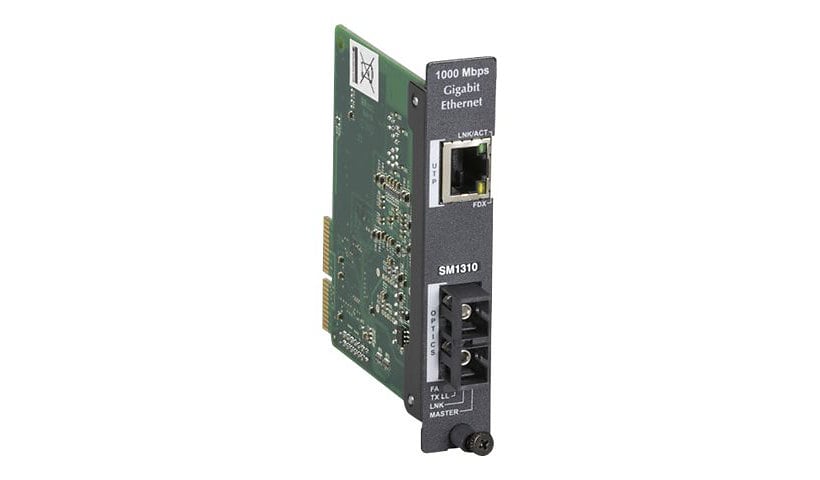
Quick tech specs
- Density Media Converter System II
- Fiber media converter
- 1000Base-LX
- RJ-45 / SC single-mode
- 1310 nm
- Layer 1 Module
- GigE
- 1000Base-T
- up to 15 km
- TAA Compliant
Know your gear
Managed Modular Media Converter Solution. This Layer 1 module for the High-Density Media Converter System II belongs to a large family of modular media converter and communications options for your managed enterprise network. With many modules to choose from this system can adapt to even the most demanding network configurations.
The modular media converters for the High-Density Media Converter System II convert the incoming electrical signal from one cable type and then transmit it over another type. Bridging the gap between two different Ethernet types the media converters are totally transparent to network operation having no effect on the data being sent across the link. What's more all the modules are hot-swappable you never need to power down a chassis to change a module.
The High-Density Media Converter System II 1000BASE-TX to 1000BASE-LX Duplex Layer 1 Module featured here is ideal for establishing longer Gigabit runs across your campus and beyond. They give you blazing Gigabit throughput over duplex fiber at distances of up to 15 kilometers (9.3 mi.).
The module also has a LinkLoss feature which notifies you of "silent failures" on copper-to-fiber links. LinkLoss enables you to troubleshoot network problems just by looking at the media converter's Link LED the link status of the fiber segment will always be reflected by the twisted-pair segment so you're informed quickly of fiber problems.
Additionally the module features Link Fault Pass-Through (LFPT) which is a troubleshooting feature that combines TX and FX LinkLoss from the local and remote devices. With LFPT enabled when a link fault is sensed it will pass through the device at each segment. In this way both switches are alerted to a fault in the line and they will send out traps. The SNMP server receives the traps and takes appropriate action to remedy the situation (usually by alerting a network administrator).
The Configuration Control feature retains the latest configuration regardless of whether it was set through DIP switch settings or SNMP.
The modular media converters for the High-Density Media Converter System II convert the incoming electrical signal from one cable type and then transmit it over another type. Bridging the gap between two different Ethernet types the media converters are totally transparent to network operation having no effect on the data being sent across the link. What's more all the modules are hot-swappable you never need to power down a chassis to change a module.
The High-Density Media Converter System II 1000BASE-TX to 1000BASE-LX Duplex Layer 1 Module featured here is ideal for establishing longer Gigabit runs across your campus and beyond. They give you blazing Gigabit throughput over duplex fiber at distances of up to 15 kilometers (9.3 mi.).
The module also has a LinkLoss feature which notifies you of "silent failures" on copper-to-fiber links. LinkLoss enables you to troubleshoot network problems just by looking at the media converter's Link LED the link status of the fiber segment will always be reflected by the twisted-pair segment so you're informed quickly of fiber problems.
Additionally the module features Link Fault Pass-Through (LFPT) which is a troubleshooting feature that combines TX and FX LinkLoss from the local and remote devices. With LFPT enabled when a link fault is sensed it will pass through the device at each segment. In this way both switches are alerted to a fault in the line and they will send out traps. The SNMP server receives the traps and takes appropriate action to remedy the situation (usually by alerting a network administrator).
The Configuration Control feature retains the latest configuration regardless of whether it was set through DIP switch settings or SNMP.
